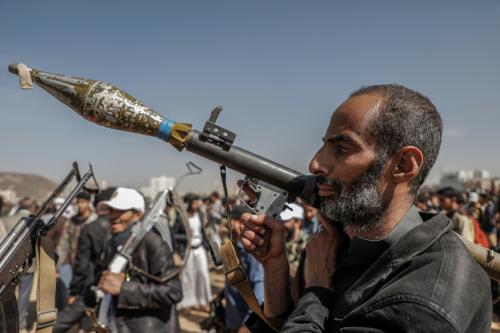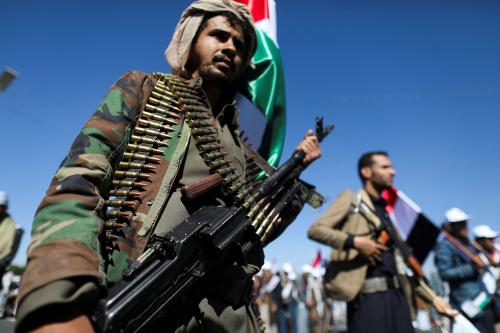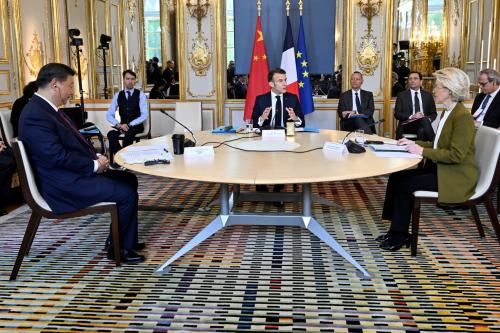Since the Houthis began attacking international shipping, media coverage and official statements have defined them as an Iranian proxy, but this downplays the Houthis’ threat and obscures the solution to it. In truth, the Houthis are not an Iranian proxy, even though they benefit from Iranian support. Rigorous definitions of the term “proxy” require that the sponsor has some means of controlling the proxy, as this is what differentiates a proxy from a partner/ally. But Iran lacks control over Houthi behavior and the Houthis are not acting primarily on behalf of Iran. This is important because the Houthis have demonstrated that they are often a more unpredictable and aggressive actor than their Iranian supporters.
Rather than being part of a centralized proxy system, the Houthis are an independent part of an increasingly complex network that allows them to work directly with over a dozen other groups to share expertise, coordinate activities, and even collaborate on joint attacks. This web enables a proliferation of chaos far beyond what Iran could orchestrate by itself, and beyond what it can effectively control. For this reason, attempts to address the Houthis’ threat by putting pressure on or engaging with Iran are doomed to fail.
The Houthis are an independent actor
After a Houthi drone killed an Israeli citizen and wounded several others in Tel Aviv on July 19, the Houthis quickly announced that Iran only learned of the attack after the fact in an attempt to assert their own independence. The Houthis have consistently demonstrated that they retain sole authority over decisionmaking. At times, this has included taking actions that run counter to Iranian interests, as they did by declaring a unilateral cease-fire with Saudi Arabia in 2019, even as Iran sought to use the Houthis to escalate tensions in the region.
The Houthis have also tried to mitigate their dependence on Iranian weapons flows, securing critical weapons parts from China, developing independent financing schemes for weapons procurement, and now pursuing military support from Russia. While still dependent on external parts, the Houthis have improved their ability to manufacture weapons inside of Yemen and have honed their independent expertise with new weapons, leveraging the fact that they are battle-tested in a way Iran is not. Over the past several months alone, they have rapidly improved their use of unmanned surface vessels, allowing them to sink a Greek coal ship in June.
The Houthis’ independence from Iran is important because the Houthis are currently more likely than Iran to escalate. The Houthis are less vulnerable than Iran to U.S. and international pressure, meaning they can afford to take greater risks. After several years of a Saudi-led coalition air campaign, the Houthis have grown accustomed to shielding their weapons supply from airstrikes, which is why recent U.S. and U.K. strikes have failed to significantly erode the Houthis’ attack capabilities.
The Houthis are also less vulnerable to international sanctions, as they operate largely outside of the international financial system. Iran has been forced to cope with domestic unrest and the economic impact of financial sanctions. Yemenis, on the other hand, have been facing one of the world’s worst humanitarian crises for a decade, making them unfortunately more accustomed to the economic deprivation and violence that the Houthi approach has perpetuated in the country.
In Yemen, conflict has become the norm in a way that is not the case in Iran, and the Houthis have presented themselves as the sole defenders of Yemen against external aggression—a narrative that depends on continued conflict. For years, that “aggression” came from the Saudi-led coalition, but this year, the narrative expanded to include the United States. And after January 20, Israel, arguably the most compelling foe for the Houthis and their supporters, joined the fray. In this way, Israel’s retaliatory strikes on Yemen in July will serve to greatly embolden the Houthis and incentivize them to pursue continued and even greater conflict with Israel, potentially even after a Gaza cease-fire is in place. While the Houthis have framed their maritime and regional attacks in the context of the Gaza war, Yemen analysts widely agree that the Houthi’s attacks are largely driven by their own domestic imperatives and regional ambitions, such that the threat will likely persist even after a Gaza cease-fire is in place.
The Houthis as a new model of Iranian support
The tendency to consider all Iranian-backed groups as proxies may be due to the fact that Lebanese Hezbollah, the most powerful Iranian-backed group in the region, is in fact a proxy that has served as a model for Iran’s support to other groups. But this is an oversimplification: The level and nature of Iran’s support to groups like the Houthis and Hamas never came close to what it provided Hezbollah (the U.S. government assesses Iran still provides $700 million annually to Hezbollah), and they never shared Iran and Hezbollah’s level of ideological alignment. Replicating the decades-long, major investment Iran made in Hezbollah would be impractical at scale.
Iranian support for the Houthis instead represents a different model: limited initial investments in a group that shares some ideological alignment but comes from a distinct religious background (the Houthis ascribe to the Zaydi branch of Shia Islam, which varies significantly from the Twelver branch dominant in Iran). That investment then expands over time as the group demonstrates its strength, while Iran cedes control over the group’s decisionmaking but seeks to strengthen their ideological alignment. Because this model requires much fewer resources and works with groups that do not adhere to Iran’s Twelver Shia branch of Islam, Iran can effectively deploy this model across the Middle East and beyond.
The Houthis’ role in a larger network
When analysts and officials center Iran in the Houthi’s attacks, they misconstrue the nature of the network that has developed between the Houthis and other Iranian-backed groups. Because the Houthis work directly with many of the groups in this network, it creates a greater, more diffuse threat that may or may not involve Iran.
In June, the Houthis claimed a joint attack with the Islamic Resistance of Iraq on Israel’s Haifa port. Such coordinated attacks from multiple directions could become more regular and complicate defensive efforts. The Houthis’ cooperation could extend beyond the Middle East as well. U.S. officials recently reported that the Houthis are providing weapons to Somali militant group al-Shabab; coordinated attacks between the Houthis and al-Shabab against ships in the Gulf of Aden and the Arabian Sea could further raise the costs of maritime shipping and frustrate U.S. attempts to combat the attacks. While only a fraction of Houthi attacks have resulted in serious damage to ships, they have stopped major shippers from sailing through the Red Sea, forcing a diversion to longer and costlier routes with cascading consequences for the industry. According to the Drewery World Container Index, container shipping costs have increased almost four-fold since the Houthi attacks began.1
This interconnected network also yields a faster proliferation of weapons and expertise. The Houthis have used years of war to hone their expertise and experiment with modifications to Iranian weapons—allowing them to successfully send drones over 1,600 miles and sink ships using unmanned boats. The Houthis’ direct engagement with groups like Hezbollah, who has similarly battled with its more powerful neighbors, was important to their development, and now the Houthis may share their expertise with other groups in the Middle East and Africa, exponentially increasing the regional threat.
Iran is not the solution to the Houthi threat
For too long, countries have sought to solve the Houthi threat via pressure on or engagement with Iran. This approach assumes that Iran either controls the Houthis, or that it has sufficient leverage to convince them to fundamentally change their behavior. Even if Iran were willing to cut off its support to the Houthis—which appears unlikely—the Houthis’ attempts to minimize their dependence on Iran and the diffuse nature of the network of Iranian-supported groups means the Houthis would endure.
Saudi Arabia’s détente agreement with Iran in March 2023 is perhaps the clearest example of why this approach is flawed. Many analysts hoped the agreement could help resolve the conflict in Yemen and promote regional stability. But that did not occur. By the time China helped broker that agreement, Yemen was a year into a U.N.-mediated truce that continues to prevent major Houthi attacks on Saudi Arabia. It was not the agreement with Iran that allowed Saudi Arabia to de-escalate with the Houthis, it was the Yemen agreement that created the space for the Saudis to de-escalate with Iran. The Saudis realized that the solution to their Houthi problem did not run through Tehran but Sanaa. Israel and others who have focused on the Houthis as part of an Iranian threat, and countries like China that seek to appeal to Tehran to change Houthi behavior in the Red Sea, have not yet learned this lesson.
There is no easy solution to the Houthi threat. Addressing this threat requires either eliminating the Houthi’s capability to conduct disruptive attacks—which both a major Saudi-led coalition and more limited U.S. and U.K. strikes have failed to do—or changing the Houthis’ intent. A U.N.-led peace process in Yemen has sought to achieve the latter by shifting the Houthis’ incentives. However, the war in Gaza and a profound power imbalance between the Houthis and other Yemeni parties have complicated these efforts. Still, the April 2022 truce is evidence that the Houthis’ incentives can be shifted away from continued war. The challenge will be striking a careful balance that does not simply appease the Houthis and embolden them to launch a new round of violence.
-
Footnotes
- Drewery provides a composite index for major global container shipping routes. The rate surged from $1,342 in October 2023 before the Houthis began attacks to a peak of $5,937 in July 2024; rates decreased slightly to $5,181 as of late August 2024.






Commentary
The danger of calling the Houthis an Iranian proxy
September 3, 2024